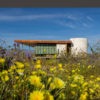Architecture has been recognized as the Queen of the Arts. It is the art that is seen by anyone walking or driving by a building—one does not have to pay to see it. It affects the behavior of the users of the building. Moreover, buildings impact not only those near the building, but those afar. Architecture is truly in the public domain. And the palette of materials from which an architect designs is the largest, deepest, most diverse, and the most complex in their interactions of any that an artist might use.
The title Architect is derived from archi (Latin and Greek) for chief, and tekton (Greek) for carpenter, particularly as a carpenter applies art. Thus, the term Master Builder has, until recently, been used for architect. The State Board of Architecture, immediately after its formation by the California Legislature in 1901, reinforced this view of the profession. They required that any candidate for the title Architect must demonstrate “knowledge of the design and construction of buildings and to supervise the execution of the work.”
Today the architect is no longer the “chief” with regard to how buildings come about. Not only are we no longer the carpenters, the builders, or even overseers of the construction process; too often we no longer adequately know how buildings go together or how to document how they go together. We, as a profession, have lost the Art of Building.
The ultimate decisions about buildings are made by other players in the entitlement, financing, construction, and development processes. The newest, and “hottest,” project delivery system is design-build, in which the architect often works for the building contractor. Construction managers have taken over a large portion of architects’ traditional work. Value engineers redesign architects’ work to get projects within budget. Government agencies interpret codes. Banks determine the feasibility of projects. Many clients do not want the design architect to be involved during construction. The architect is no longer even the final arbiter of the building’s design. For architects again to be Master Builders, or even to regain their former influence, the profession must recapture the Art of Building. The process by which we prepare architects for practice must be improved.
How are we currently passing on the body of knowledge of the architectural profession through our educational, experiential, and examination processes? On the examination side, we have a California Supplemental Examination that queries applicants on their knowledge of practice areas peculiar to California and California practice areas not adequately covered in the national ARE (Architectural Registration Exam). An outstanding question about the exams is whether or not the comprehensive design examination, which was dropped by NCARB (National Council of Architectural Registration Boards) in 1995, should again be required to demonstrate that candidates can synthesize the elements of a building, within the many real-world constraints, and actually design a functional building.
To improve experiential preparation for practice, the CAB (California Architects Board) is requiring aspiring architects, subject to regulatory approval and as of January 1, 2005, to enroll in and complete the national IDP (Internship Development Program). California is also including a comprehensive requirement (C-IDP). This program will ensure that interns have a more diverse and thorough experience during the time between their formal education and licensure.
Education is the foundation upon which experience and internship grow. But a large gap exists between education and practice, as evidenced in forty years of innumerable articles in professional journals, studies, and books by architects, academicians, sociologists, and government agencies.
NCARB’s “Architectural Practice Analysis Study,” completed last year, identifies areas with the greatest gaps between education and practice. Those areas mirror the practice competencies that need improvement according to the California Board of Architects’ “Post Licensure Proficiency Survey.” Both conclude that architects should improve their proficiency, knowledge, and competency in four core areas: (1) codes and regulations, (2) complete and coordinated construction documents, (3) construction contract administration, and (4) communication: written, verbal, and graphic. These two studies demonstrate that subjects not taught to a student in architecture school remain as weak spots throughout that architect’s professional life.
Architectural educators correctly argue that one of their roles is to teach students how to think and how to solve problems. Knowing how to get the answer is a permanent skill: once you know the process, you will always be able to get the answer. They do not teach all the answers, but educators claim that they teach how to get the answers. But how can graduates learn to get answers for those areas not even addressed in studios or other course work?
Unfortunately, the typical schools of architecture, in studio classes, only go through schematic design and, sometimes, into design development. Construction documents classes are rarely mandatory, and when taught are usually a part of a limited professional practice course.
Should not the entire process of designing a building, and how it is to be constructed, be formally taught in school? Should not the studio culture be changed to take students through the entire architectural process, and to integrate all the aspects that determine the design, documentation, and construction of a building? Knowing the basics of that process, interns can then apply this knowledge to the varying situations in which they find themselves.
Architecture is an applied art. What must be applied are not only aesthetics, form, site conditions, and meeting the design program, but the total function of the building, including codes (arguably the largest design determinant), major building systems, materials and methods, and constructability.
One of the greatest challenges facing academia is to how to teach students that the integration of these areas into design is essential. How can they be made less mundane? Students must understand that architects must design within the constraints of the real world, or must design around those constraints. All too often, however, the goal of the studios is to not constrain the student by the “facts of life” of the real world. They are encouraged to “think outside the box.” But how can one think outside the box until one knows what the box is? Cannot the pure art of design be offered in an art class, rather than in an architectural design studio?
The Queen of the Arts is dependent on the Art of Building. It defines our constructed environment. Designing buildings correctly is essential to protect the public health, safety, and welfare. The profession of architecture must recapture the Art of Building.
Author Kirk Miller, FAIA, CDS, is a member and past president of the California Architects Board. He has served the AIA as Secretary of the California Council and as Chair of the National Ethics Council. He is one of the authors of the national AIA Code of Ethics. Miller is in private practice in San Francisco. He received his Master of Architecture degree from UC Berkeley and his Bachelor of Arts degree from the University of Alberta. This article is the personal perspective of the author, and not the policy of the California Architects Board.
Originally published 1st quarter 2003, in arcCA 03.1, “Common Knowledge.”





